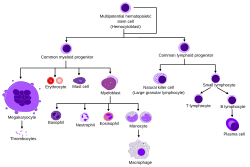Hematopoietic stem cell
| Hematopoietic stem cell | |
|---|---|

Overview of normal human hematopoiesis
|
|
| Details | |
| Identifiers | |
| Latin | Cellula haematopoietica praecursoria |
| Code | TH H2.00.01.0.00006 |
|
Anatomical terminology
[]
|
|
Hematopoietic stem cells (HSCs) or hemocytoblasts are the stem cells that give rise to all the other blood cells through the process of haematopoiesis. They are derived from mesoderm and located in the red bone marrow, which is contained in the core of most bones.
HSCs give rise to both the myeloid and lymphoid lineages of blood cells. (Myeloid cells include monocytes, macrophages, neutrophils, basophils, eosinophils, erythrocytes, dendritic cells, and megakaryocytes or platelets. Lymphoid cells include T cells, B cells, and natural killer cells.) The definition of hematopoietic stem cells has evolved since HSCs were first discovered in 1961. The hematopoietic tissue contains cells with long-term and short-term regeneration capacities and committed multipotent, oligopotent, and unipotent progenitors. HSCs constitute 1:10.000 of cells in myeloid tissue.
HSC studies through much of the past half century have led to a much deeper understanding. More recent advances have resulted in the use of HSC transplants in the treatment of cancers and other immune system disorders.
HSCs are found in the bone marrow of adults, especially in the pelvis, femur, and sternum. They are also found in umbilical cord blood and, in small numbers, in peripheral blood.
...
Wikipedia
